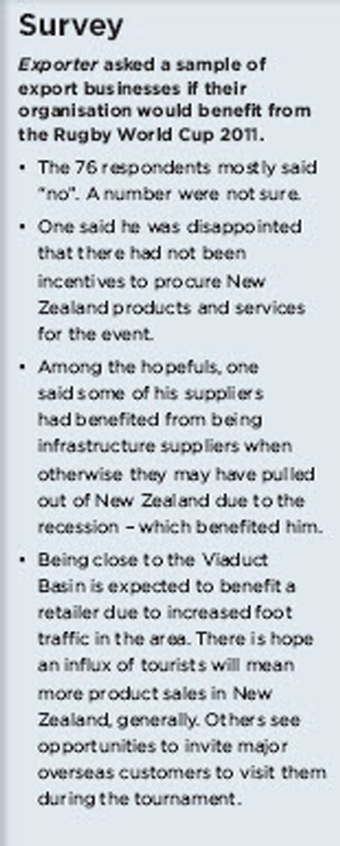Tracking systems are getting more sophisticated. The race is on to not only keep an eye on your products from afar but to trim the cost of moving them to their final destination.
Like many technologies, tracking services have gone from something unique to mainstream – fleet tracking and goods tracking are now available to most companies, no matter what size.
As Anthony Browne, CEO of New Zealand Agility Logistics, says: “For most exporters, it has become a prerequisite to have goods tracked and to provide tracking information to customers. Most companies have tracking systems online, where customers can type in a number and get information about where their goods are.”
Browne points out that this is the minimal expectation of tracking, but companies such as Agility Logistics look to put more value into tracking. And here’s the rub – when looking at what companies offer, “tracking” doesn’t always mean the same thing. It could be the basic “check on the web” where your parcels are and when they are expected to be delivered, or more advanced technology.
Along with Agility Logistics, other key market players include Hemisphere Freight, PBT Group and TNT.
TIME-CONSUMING
According to Browne, tracking alone is not enough. “If you’re a larger company, you may have 50 items en route at the same time. Do you want to be spending time typing 50 numbers into a tracking site daily? No.”
 He says his company’s role in terms of exporters is very important. “We’re the final link in the supply chain. All the energy and commitment, time and money you put into your business comes to very little if an exporter’s logistics partner doesn’t complete its part well. All that work can come to nothing.
He says his company’s role in terms of exporters is very important. “We’re the final link in the supply chain. All the energy and commitment, time and money you put into your business comes to very little if an exporter’s logistics partner doesn’t complete its part well. All that work can come to nothing.
“We’re about getting the goods delivered. It’s a competitive market, so it’s in our interests to develop cutting-edge technology for tracking.”
Browne says his company uses the latest tracking systems. This means proactive email notification, online documentation (where you and your customer can view relevant shipping documentation) and more.
“We measure expected delivery and actively monitor things, so we can check for delays. This gives customers the ability to keep control over freight movement with minimal effort.
“Traditionally, you would log into an internet site, enter a number and the onus would be on you to seek the information required. With our system, customers are alerted to any issues, so they don’t have to log into a site every day.”
CUSTOMISING WHAT IS TRACKED
Browne says the information you receive is customisable. “Some people want information on every event, some only want to know if there is a delay. You can avoid information overload and ask to be alerted only if an event has affected something. If everything’s on schedule, you probably don’t have to know. Second-generation tracking accepts that all customers have different requirements. We try to see what best suits a particular business.
“Receivers of goods can also receive notifications if the exporter chooses. This stops double handling of information.”
With this system, the exporter can restrict access to what the receiver of goods can see. “You can make sure they have access only to what’s been delivered to them, not the full order.”
Browne says his company does not charge for the tracking part of the service. “It’s about adding value to our customers and differentiating ourselves from competitors.
“We look at our customers and their needs. As they get larger and more complex, their needs grow – and we need to adapt to their needs. The prospect of working with a logistics partner without cutting-edge technology would mean more work for the exporter.
“There are serious players in our industry. The competition means we have to keep ahead.”
CAN THE SYSTEM DELIVER?
Hemisphere Freight general manager Rodney Hughes says exporters need to be mindful of two things when evaluating tracking systems: can the tracking system reduce internal costs, and will it provide an efficient service to their clients?
“As a result of the development of our system, HemiTrack, over the past six years we have implemented tracking systems that have achieved both of these objectives for our clients.
 “A common method is to allow customer services representatives, who normally have no actual involvement in shipping, access to product availability and delivery information to respond to client enquiries.
“A common method is to allow customer services representatives, who normally have no actual involvement in shipping, access to product availability and delivery information to respond to client enquiries.
“This is ‘live’ data, available 24 x 7, via the internet, in any easy-to-use format, and achieved by collecting the product detail within export orders.”
He says Hemisphere can also customise HemiTrack according to clients’ needs.
“Hemisphere can also develop electronic data transfers and web services to reduce costs and improve customer service.”
A powerful feature of Hemisphere’s service is the ability to find out which container a particular product is in. “Our customers can say they want that container offloaded first and delivered first if there is a hurry – even when it’s en route. It’s about product rather than shipment tracking,” he says.





